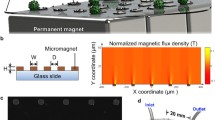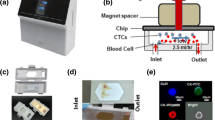Abstract
Circulating tumor cell detection is one important avenue for early cancer diagnosis. A differential solid-state micropore approach is reported that detects a very low number of tumor cells from blood samples. One micropore is functionalized with an aptamer molecule specific to epidermal growth factor receptor (EGFR), known to be overexpressed on cancer cell surfaces, whereas the other micropore is bare. The translocation behavior of tumor cells is seen to be distinctly different from normal counterparts and control when passed through functionalized micropore. The differentiation stems from the selective interactions between the aptamer molecules and overexpressed EGFR on the tumor cells. Normal cells, on the other hand, do not show selective interaction with aptamers. As a result, cancer cells are distinguished from normal cells just by looking at the translocation data from an aptamer-functionalized micropore. The interactions between the cells and the aptamer in a micropore provide a detection modality that interrogates each cell.







Similar content being viewed by others
References
Anand P, Kunnumakara AB, Sundaram C, Harikumar KB, Tharakan ST, Lai OS, Sung B, Aggarwal BB (2008) Cancer is a preventable disease that requires major lifestyle changes. Pharm Res 25(9):2097–2116
Asghar W, Ilyas A, Deshmukh RR, Sumitsawan S, Timmons RB, Iqbal SM (2011) Pulsed plasma polymerization for controlling shrinkage and surface composition of nanopores. Nanotechnol 22(28):285304–285311
Asghar W, Wan Y, Ilyas A, Bachoo R, Kim Y-t, Iqbal SM (2012) Electrical fingerprinting, 3D profiling and detection of tumor cells with solid-state micropores. Lab Chip 12(13):2345–2352
Baas IO, Berg FMVD, Mulder J-WR, Clement MJ, Slebos RJC, Hamilton SR, Offerhaus GJA (1996) Potential false-positive results with antigen enhancement for immunohistochemisty of the p53 gene product in colorectal neoplasms. J Pathol 178(3):264–267
Bunka DHJ, Stockley PG (2006) Aptamers come of age—at last. Nat Rev Microbiol 4(8):588–596
Bustin SA, Gyselman VG, Siddiqi S, Dorudi S (2000) Cytokeratin 20 is not a tissue-specific marker for the detection of malignant epithelial cells in the blood of colorectal cancer patients. Int J Surg Investig 2(1):49–57
Chang H, Ikram A, Kosari F, Vasmatzis G, Bhunia A, Bashir R (2002a) Electrical characterization of micro-organisms using microfabricated devices. J Vac Sci Tech B Microelectronl Nanom Struct 20(5):2058–2064
Chang WC, Liepmann D, Lee LP (2002b) A biomimetic method for extracting leukocytes from blood in microfluidic devices. Microtechnol Med Biol 2nd Annu Int IEEE-EMB Spec Top Conf, pp 184–188
Charlton J, Sennello J, Smith D (1997) In vivo imaging of inflammation using an aptamer inhibitor of human neutrophil elastase. Chem Biol 4(11):809–816
Chen HW, Medley CD, Sefah K, Shangguan D, Tang Z, Meng L, Smith JE, Tan W (2008) Molecular recognition of small-cell lung cancer cells using aptamers. ChemMedChem 3(6):991–1001
Chien S, Luse SA, Bryant CA (1971) Hemolysis during filtration through micropores: a scanning electron microscopic and hemorheologic correlation. Microvasc Res 3(2):183–203
Dalle F, Lopez J, Caillot D, Cuisenier B, Laubriet AE, Dumont L, Bonnin A (2002) False-positive results caused by cotton swabs in commercial Aspergillus antigen latex agglutination test. Eur J Clin Microbiol Infect Dis 21(2):130–132
Farokhzad OC, Jon S, Khademhosseini A, Tran T-NT, LaVan DA, Langer R (2004) Nanoparticle-aptamer bioconjugates a new approach for targeting prostate cancer cells. Cancer Res 64(21):7668–7672
Hanahan D, Weinberg RA (2011) Hallmarks of cancer: the next generation. Cell 144(5):646–674
He W, Wang H, Hartmann LC, Cheng J-X, Low PS (2007) In vivo quantitation of rare circulating tumor cells by multiphoton intravital flow cytometry. Proc Natl Acad Sci 104(28):11760–11765
Heron M (2011) Deaths: leading Causes for 2007. Natl Vital Stat Rep 59(8):1–95
Huang LR, Cox EC, Austin RH, Sturm JC (2004) Continuous particle separation through deterministic lateral displacement. Sci 304(5673):987–990
Iqbal SM, Akin D, Bashir R (2007) Solid-state nanopore channels with DNA selectivity. Nat Nanotechnol 2(4):243–248
Kitamura A, Hosoda W, Sasaki E, Mitsudomi T, Yatabe Y (2010) Immunohistochemical detection of EGFR mutation using mutation-specific antibodies in lung cancer. Clin Cancer Res 16(13):3349–3355
MacDonald MP, Neale S, Paterson L, Richies A, Dholakia K, Spalding GC (2004) Cell cytometry with a light touch: sorting microscopic matter with an optical lattice. J Biol Regul Homeost Agents 18(2):200–205
Markowitz SD, Bertagnolli MM (2009) Molecular basis of colorectal cancer. N Engl J Med 361(25):2449–2460
Mendelsohn J (2004) EGF receptors as a target for cancer therapy. Trans Am Clin Climatol Assoc 115:249–254
Mohamed H, McCurdy LD, Szarowski DH, Duva S, Turner JN, Caggana M (2004) Development of a rare cell fractionation device: application for cancer detection. NanoBiosci IEEE Trans 3(4):251–256
Nagel-Wolfrum K, Buerger C, Wittig I, Butz K, Hoppe-Seyler F, Groner B (2004) The interaction of specific peptide aptamers with the DNA binding domain and the dimerization domain of the transcription factor Stat3 inhibits transactivation and induces apoptosis in tumor cells. Mol Cancer Res 2(3):170–182
Nagrath S, Sequist LV, Maheswaran S, Bell DW, Irimia D, Ulkus L, Smith MR, Kwak EL, Digumarthy S, Muzikansky A, Ryan P, Balis UJ, Tompkins RG, Haber DA, Toner M (2007) Isolation of rare circulating tumour cells in cancer patients by microchip technology. Nat 450(7173):1235–1239
Normanno N, De Luca A, Bianco C, Strizzi L, Mancino M, Maiello MR, Carotenuto A, De Feo G, Caponigro F, Salomon DS (2006) Epidermal growth factor receptor (EGFR) signaling in cancer. Gene 366(1):2–16
Paterlini-Brechot P, Benali NL (2007) Circulating tumor cells (CTC) detection: clinical impact and future directions. Cancer Lett 253(2):180–204
Phillips JA, Xu Y, Xia Z, Fan ZH, Tan W (2008) Enrichment of cancer cells using aptamers immobilized on a microfluidic channel. Anal Chem 81(3):1033–1039
Roberts GS, Kozak D, Anderson W, Broom MF, Vogel R, Trau M (2010) Tunable nano/micropores for particle detection and discrimination: scanning ion occlusion spectroscopy. Small 6(23):2653–2658
Strutwolf J, Scanlon MlD, Arrigan DWM (2009) Electrochemical ion transfer across liquid/liquid interfaces confined within solid-state micropore arrays-simulations and experiments. Analyst 134(1):148–158
Smith RA, Cokkinides V, Brawley OW (2009a) Cancer screening in the United States, 2009: a review of current American Cancer Society guidelines and issues in cancer screening. CA Cancer J Clin 59(1):27–41
Smith RA, Cokkinides V, von Eschenbach AC, Levin B, Cohen C, Runowicz CD, Sener S, Saslow D, Eyre HJ (2009b) American cancer society guidelines for the early detection of cancer. CA Cancer J Clin 52(1):8–22
Steinle ED, Mitchell DT, Wirtz M, Lee SB, Young VY, Martin CR (2002) Ion channel mimetic micropore and nanotube membrane sensors. Anal Chem 74(10):2416–2422
Sullenger BA, Gilboa E (2002) Emerging clinical applications of RNA. Nat 418:252–258
Tibbe AGJ, de Grooth BG, Greve J, Dolan GJ, Rao C, Terstappen LWMM (2002) Magnetic field design for selecting and aligning immunomagnetic labeled cells. Cytom 47(3):163–172
Toner M, Irimia D (2005) Blood-on-a-chip. Annu Rev Biomed Eng 7:77–103
Wan Y, Kim Y-t, Li N, Cho SK, Bachoo R, Ellington AD, Iqbal SM (2010) Surface-immobilized aptamers for cancer cell isolation and microscopic cytology. Cancer Res 70(22):9371–9380
Wan Y, Liu Y, Allen PB, Asghar W, Mahmood MAI, Tan J, Duhon H, Kim Y-t, Ellington A, Iqbal SM (2012a) Capture, isolation and release of cancer cells with aptamer-functionalized glass beads. Lab Chip 22:4693–4701
Wan Y, Mahmood M, Li N, Allen PB, Kim Y-t, Bachoo R, Ellington AD, Iqbal SM (2012b) Nanotextured substrates with immobilized aptamers for cancer cell isolation and cytology. Cancer 118(4):1145–1154
Acknowledgments
We thank Azhar Ilyas and Muhymin Islam for help with the manuscript preparation and for useful discussions. The aptamers were provided by Dr. Andrew D. Ellington from the University of Texas at Austin, and tumor samples were provided by Dr. Robert Bachoo from the University of Texas Southwestern Medical Center at Dallas. This work was supported with National Science Foundation CAREER grant ECCS-1201878 and an award to SMI by the Cancer Research Foundation of North Texas, Arlington, Texas.
Author information
Authors and Affiliations
Corresponding author
Electronic supplementary material
Below is the link to the electronic supplementary material.
Rights and permissions
About this article
Cite this article
Bellah, M.M., Iqbal, S.M. & Kim, YT. Differential behavior of EGFR-overexpressing cancer cells through aptamer-functionalized micropores. Microfluid Nanofluid 17, 983–992 (2014). https://doi.org/10.1007/s10404-014-1402-2
Received:
Accepted:
Published:
Issue Date:
DOI: https://doi.org/10.1007/s10404-014-1402-2




